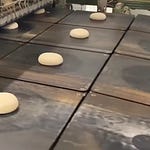These methods define not only the efficiency of the process but also the texture, yield, and sensory qualities of the final product. For producers aiming to scale efficiently while meeting market expectations, understanding this is crucial.
Dough Rheology and Gluten Development
Extrusion typically uses slightly higher hydration (58–62%) than sheeting (around 55%). This softer dough is more extensible and flows smoothly through the extruder die without tearing.
A strong yet extensible gluten network is critical for extrusion. If the dough is too stiff, the extruder may become blocked, while dough that is too slack can deform after deposition.
Adjustments such as L-cysteine to relax gluten and emulsifiers to improve gas retention and dough flow are commonly applied to optimize extrusion performance.
Sheeting works best with firmer dough that holds its shape during rolling and cutting. Gentle sheeting techniques, involving multiple gradual thickness reductions, minimize gluten damage and preserve dough structure, leading to good volume and open crumb after proofing.
Extrusion vs. Sheeting: Pros and Cons
Both methods offer clear operational benefits and trade-offs. The right choice depends on the product range, goals, and desired process flexibility.
Extrusion
Pros:
Eliminates trim waste, improving ingredient yield and minimizing rework.
Delivers precise control over size and weight, ensuring even frying and consistent quality.
Supports continuous, automated operation with minimal human handling.
Reduces production labor and simplifies process flow.
Cons:
Limited shape versatility, primarily suitable for ring donuts.
Requires strict control of dough rheology; small deviations can cause deformation or clogging.
Mechanical pressure during extrusion can increase fat absorption, slightly affecting texture and shelf life.
Sheeting and Cutting
Pros:
Enables production of multiple shapes and formats with simple tooling adjustments.
Ideal for large-scale operations that produce different product categories on a single line.
Automated lines can sustain high-speed, continuous operation when properly configured.
Cons:
Generates 10–20% scrap dough, requiring efficient rework systems to maintain yield.
Larger and more complex equipment increases maintenance and space requirements.
Excessive mechanical stress during sheeting can damage gluten structure and alter texture or oil absorption.
Managing Scrap
Managing scrap in sheeting lines typically involves two main strategies.
Reworking the Dough
Trim dough is collected through automated return conveyors and reincorporated into fresh batches.
This reduces ingredient waste and allows efficient use of raw materials. However, if too much dough is reworked, it may lead to over-fermentation, weaker structure, or inconsistent quality in the final product.
Slurry Rework System
It’s an increasingly popular solution in high-capacity lines.
In this approach, trim dough is automatically collected, hydrated with a small amount of water, and processed in a high-shear grinder to create a pumpable slurry. This slurry is then precisely dosed back into fresh dough, partially replacing flour and water.
This system provides better control over rework incorporation, improves sanitation by keeping the process closed, and allows higher rework utilization without compromising quality.
However, it requires specialized equipment and precise dosing control to maintain consistent dough characteristics.
Scalability in Practice
Sheeting lines dominate high-volume industrial production, with capacities exceeding 40,000 donuts/hour on wide belt systems. They are modular, allowing scaling through belt width or multiple parallel lines.
Extrusion systems typically achieve 1,500–10,000 donuts/hour per line. For higher volumes, multiple extruders are installed in parallel.
Product Texture and Mouthfeel
Extruded donuts:
Uniform, fine crumb structure due to compression through the die.
Slightly denser texture with a subtle chew.
Typically absorb slightly more frying fat, creating a richer mouthfeel.
Sheeted-and-cut donuts:
More open, airy crumb from gentler handling.
Fluffy and light mouthfeel with moderate oil absorption. Sheeted donuts absorb less fat when frying due to the intact dough structure and strong gluten network, which typically results in a cleaner, less greasy finish compared to extruded donuts.
Market Preferences and Product Segments
Consumer expectations often shape the choice of production method:
Ring-donut chains rely on extrusion for efficiency, uniformity, and zero waste.
Industrial producers with diverse portfolios favor sheeting for flexibility.
Artisan shops often hand-cut or use small sheeters to achieve fluffy, irregular textures that signal craft quality.
Regional differences matter: European consumers often prefer ultra-soft, melt-in-mouth donuts, whereas U.S. consumers are more tolerant of slightly chewier textures.
👉 Thanks for reading! 💬 Any experiences to share with us?? – We’d love to hear your story!
Sources: https://tinyurl.com/3nfrkarr










